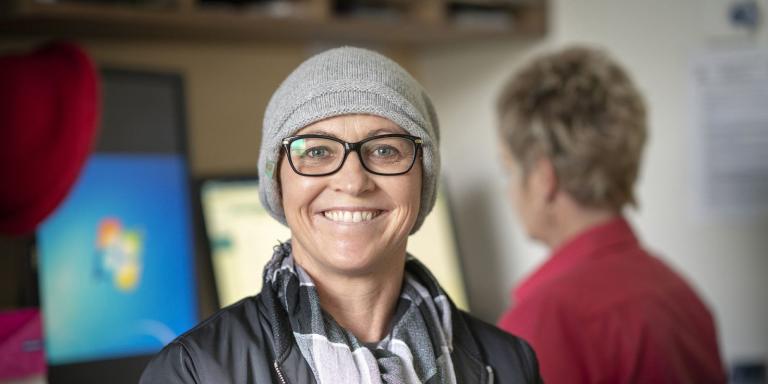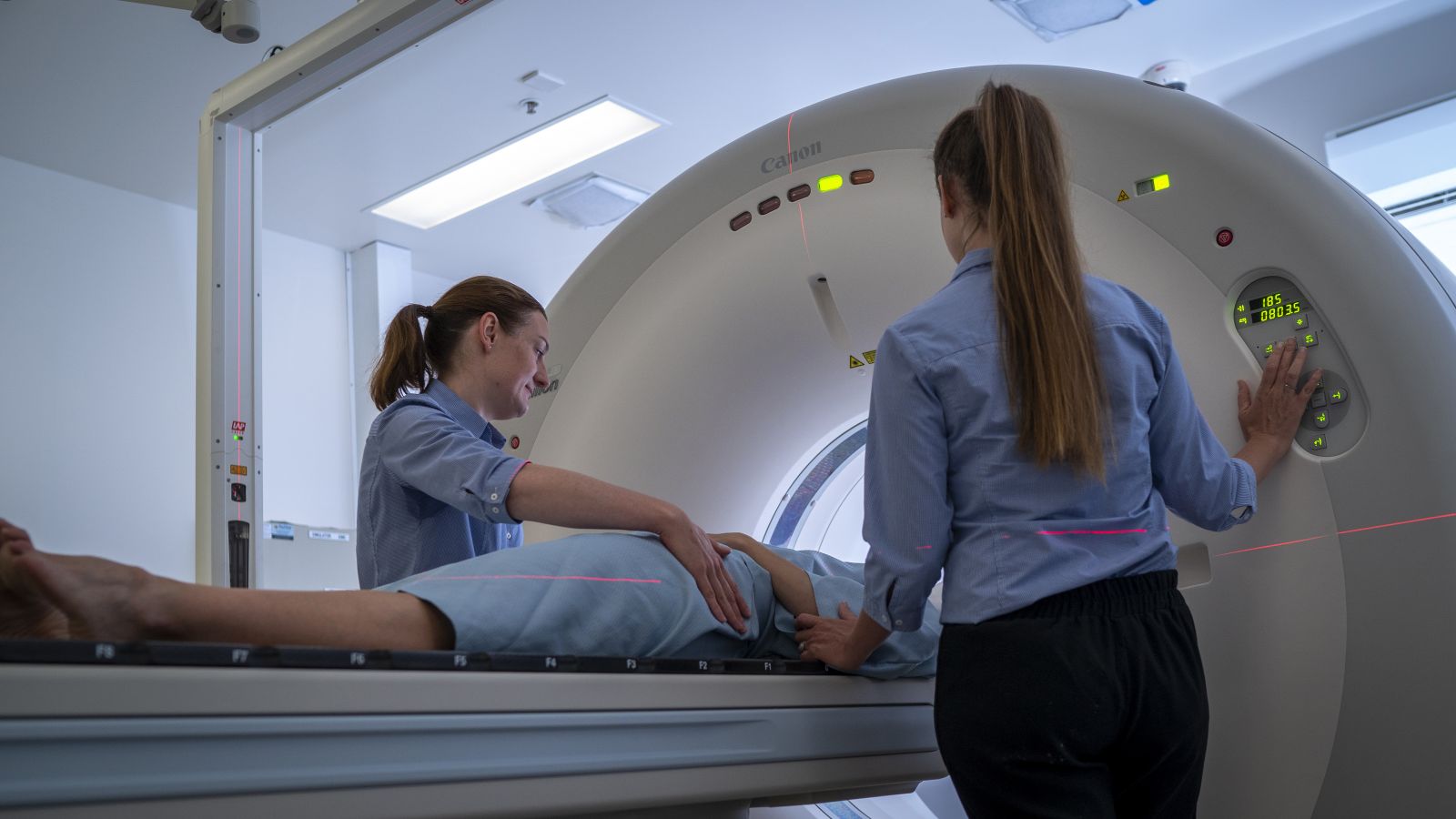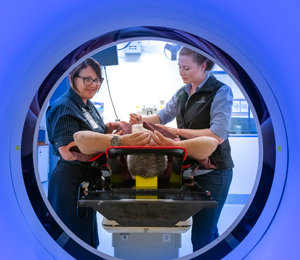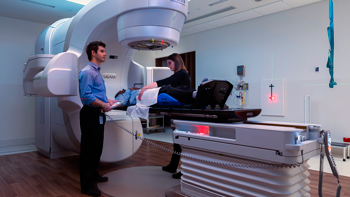
Radiation therapy
Northern Cancer Service

What is radiation therapy?
Radiation therapy is a type of cancer treatment that uses highly localized beams of intense ionising radiation to kill cancer cells. Radiation therapy most often uses X-rays, but other types of energy can also be used.
Radiation can destroy cancer cells located in the area of treatment. It can also affect normal healthy tissue within the treatment area. The body can repair these injured, normal healthy cells and they regrow. The cancer cells can't repair themselves in the same way, so they are destroyed.
For this reason, treatment is usually broken up into many sessions of 4-5 times a week. This gives the healthy cells time to recover, whilst still working to destroy the cancer cells with every treatment. The type and stage of cancer will determine how much radiation needs to be given and for how many days.
Radiation Oncology teams are made up of the treating Radiation Oncologist, Radiation Therapists and Medical Physicists, as well as other health care professionals such as Nurses and Social Workers. Together they will tailor an individual treatment plan so that you have the best possible care and treatment.
Your Radiation Oncologist will work with you to develop a treatment plan and will always discuss options and decisions with you and your family.
For more information about radiotherapy visit the Targeting Cancer website or speak to your treating team at your next appointment.
Simulation and planning
Before your radiotherapy treatment can begin, you will have a treatment planning procedure called a simulation. This is done to make sure that important information regarding your position is recorded so that this position can be re-produced during treatment. You will be contacted with a simulation appointment time and any preparation for this appointment will be explained to you.
On the day of your simulation appointment, you will also receive an appointment to see a Radiotherapy Nurse and Social Worker. They will discuss the process and side effects of treatment with you and how these side effects can be minimised. Our Social Workers will provide any support you may require such as transport, accommodation, financial support and emotional support.
During your simulation appointment:
- Depending on the area of your body being treated, you may be asked to remove some items of clothing.
- You will be asked to state your full name, date of birth and the area being treated. You will be asked this many times during your treatment journey and this is done for your safety. People with the same or similar name may be in the department on the same day as you.
- Two Radiation Therapists will be responsible for the simulation session.
- The area of the body being treated will determine the position you will be in and what kind of equipment is used. Your treatment position and the equipment used will help you stay in the same position each day while on treatment. It is important to let your Radiation Therapist know if you are uncomfortable at any time during the simulation so your position can be adjusted, as it cannot be changed once on treatment.
- Once in position, you will have a computed tomography (CT) scan. The images from the scan will be used to plan your treatment.
- Measurements and photographs will be taken and for some treatment areas. You may be marked with little tattoo dots. These marks are important as they will help the Radiation Therapists move you into the same position each day for treatment.
This appointment takes 30 minutes to 1 hour depending on the area of the body being treated. Once the simulation appointment is completed the Radiation Therapists and the Radiation Oncologist draw up your unique plan. The Radiation Therapist will give you a call to let you know the date and time of your first treatment session, where you will receive a list of your appointments for the remaining sessions.
Treatment
When you arrive at the W.P. Holman Clinic or North West Cancer Centre, check-in at the Radiation Therapy reception desk and have a seat in the waiting room. Parking permits for the W.P. Holman Clinic can be organised at the reception desk.
On your first day, a Radiation Therapist will see you and give you an overview of the process for your appointment. They will direct you to a private area if you need to get changed for the treatment appointment. At any time feel free to ask questions as they can provide answers or will assist in referring the question to the appropriate team member.
 The radiation treatment will usually take 12-24 minutes depending on the treatment site. Your first day may take a little longer. The Radiation Therapists will begin by setting you up in the same position as your simulation scan. They will take some measurements and let you know when they are leaving the room, and a doorbell will sound. From outside the room, the Radiation Therapists can always hear and see you during your treatment. An image of the area will be taken, and you may feel the bed move slightly, this is your final position for treatment. The radiation delivery is the quickest part of the appointment, and you will hear a loud buzzing sound when the machine is on. The most important role for you is to remain still and relaxed once you are in the treatment position.
The radiation treatment will usually take 12-24 minutes depending on the treatment site. Your first day may take a little longer. The Radiation Therapists will begin by setting you up in the same position as your simulation scan. They will take some measurements and let you know when they are leaving the room, and a doorbell will sound. From outside the room, the Radiation Therapists can always hear and see you during your treatment. An image of the area will be taken, and you may feel the bed move slightly, this is your final position for treatment. The radiation delivery is the quickest part of the appointment, and you will hear a loud buzzing sound when the machine is on. The most important role for you is to remain still and relaxed once you are in the treatment position.
After your treatment
In your last week of treatment, we will make a follow-up plan with the Radiation Oncologist. This appointment is typically arranged a few weeks to months after your last radiation treatment as the radiation will continue to work for a few weeks. Further diagnostic scans may be required, you will be informed of when and where to make an appointment. In some cases, the Radiation Nurse will continue appointments with you to manage any side effects that you may experience from the treatment. If you have any questions, concerns or are unsure please call us, we are happy to assist.
Types of radiation therapy
The W.P. Holman Clinic and the North West Cancer Centre have a range of radiation therapy treatment techniques to treat different types of cancer.
3D conformal radiation therapy (3DCRT)
This treatment is planned on the simulation computed tomography (CT) scan using planning software. The treatment plan will be individualised to each patient to deliver a conformal dose of radiation to the tumour while sparing healthy tissue surrounding the tumour.
3DCRT is used to deliver Radiation Therapy effectively to most areas of the body usually in the form of a once-off treatment or daily treatments for several weeks.
Intensity-modulated radiation therapy (IMRT)
Intensity Modulated Radiation Therapy (IMRT) is an advanced form of conformal radiation therapy delivered on a linear accelerator (treatment machine). During IMRT treatment the shielding moves while the radiation beam is turned on allowing the amount of radiation dose to be intentionally varied. Many beams from different angles are used to sculpt the radiation dose to precisely follow the shape of the tumour. This allows higher doses of radiation to be given to target volumes without increasing dose to surrounding healthy tissue. IMRT treatment can take slightly longer to complete and usually takes around 20 minutes.
Volumetric modulated arc therapy (VMAT)
Volumetric Modulated Arc Therapy (VMAT) is a treatment technique that can deliver radiation continuously as the Linear Accelerator rotates. VMAT is very similar to Intensity Modulated Radiation Therapy (IMRT). It can shape the radiation dose to the treatment volume while sparing the dose to healthy surrounding organs. VMAT uses the same type of radiation as other radiation therapy treatments and will be delivered by our Radiation Therapists.
Image–guided radiation therapy (IGRT)
Image-guided radiation therapy (IGRT) is the use of X-Ray images taken immediately before, during or after your Radiation Therapy Treatment. IGRT is used to improve the accuracy and precision of treatment by comparing the images that were taken to plan your radiation therapy with the images taken immediately before, during or after treatment. By comparing these images, the radiation therapists can ensure you are in the correct treatment position right down to the millimetre. IGRT is commonly used in most treatment areas and in conjunction with other treatment techniques.
Stereotactic body radiation therapy (SBRT)
At the WP Holman Clinic, Stereotactic Body Radiation Therapy (SBRT) is an advanced form of Radiation Therapy that is used to treat some types of cancers. It is used to treat both primary cancers (where the tumour originated) or where cancer may have spread (secondary cancers or metastases).
This technique differs from another external beam Radiation Therapy as it involves delivering much higher doses to the tumour in a reduced number of treatments.
Deep inspiration breath hold (DIBH) for left-sided breast cancer
Deep Inspiration Breath Hold (DIBH) is used for people receiving treatment for left-sided breast cancer, it is designed to protect your heart during Radiation Treatment. The technique involves holding your breath in 20-30 second intervals. Holding your breath expands your lungs to help move the heart away from the treatment area. The technique requires consistent deep breaths that can be achieved multiple times for treatment. The Radiation Therapists will monitor your breathing and give you instructions for the breath-hold.
Side effects
Each person will experience their treatment differently, because radiation therapy works by destroying cells, normal surrounding cells can also be affected by treatment. Radiotherapy is a localised treatment; side effects will commonly be related to the area where you are being treated with radiation therapy. Most side-effects can be managed and will gradually disappear once your treatment has finished.
Side effects can include:
- fatigue or tiredness
- dry, red or itchy skin
- loss of appetite
- nausea (feeling sick)
- digestive problems
- irregular bowel movements
- dry or sore throat or mouth
- cough or mild shortness of breath
During your treatment, the Radiation Therapists, Nurses and your Radiation Oncologist will see you regularly and are happy to respond to any questions or concerns about side-effects.
If you have new symptoms, side effects or have any concerns during your treatment let the administration team know when you check in for treatment and the Radiation Therapy Nurse will see you or you can ask to see the nurse on the day.
Your oncology team will work with you to reduce the side effects of radiotherapy. For example, this includes discussing things like mouth care and keeping well-hydrated, along with the use of some medications like anti-nausea tablets and steroids when needed. You may also see the Social Worker or a member of the Allied Health team to support you in managing your symptoms. Because each person is different and their treatment will vary, we will work with each patient and their family to help develop a plan of care which is best suited to them.
Please remember when looking for information about cancer, not everything relates to you. Your diagnosis is unique and information you find may not be relevant. It will be helpful to talk through any information you find with family, friends and your oncology team.
If you become suddenly unwell or very sick, it’s important to go to your local emergency department even if you are having treatment in the clinic the next day.
Frequently asked questions
Below is a list of questions and the answers that people commonly ask about radiation therapy. We encourage patients and their families to ask as many questions as they need to get a good understanding of what to expect.
Some patients say it can be helpful to keep a diary, notebook or document on your phone or tablet to record questions you think of at home or when speaking to friends and family. We are happy to help work through these questions when you are next in the clinic.
How often do I need to come for treatment?
Most radiation therapy is given daily over several weeks. Treatment is given Monday to Friday with a rest on Saturday and Sunday and public holidays. If your treatment is different to this a unique plan will be developed with you.
How long does treatment take?
The treatment itself is very quick, often taking under 30 minutes. It may take a little longer to get set up for your first few treatments or in situations where you require pain relief or physical support for comfort during the treatment.
Does radiation therapy hurt?
No, the radiation therapy itself doesn't create a feeling, what is important is that you have the right supports and pain relief so that you are comfortable during your treatment. The machine will make a buzzing noise which can be unsettling, but it is just like having a normal x-ray.
Will the treatment make me sick?
Possibly, some patients report tiredness and fatigue, however, radiation therapy treatment is localised and only affects the area that is being treated. For example, if the stomach is being treated it may cause some nausea or vomiting and if the rectum or bowel is being treated it could cause irregular bowel movements. We will arrange medication to manage these side-effects.
Will I lose my hair?
Hair loss will only occur if the scalp is being directly treated.
Will I be radioactive?
No. When the treatment machine is switched off, the radiation stops, inside and outside the body.
Can I hold children?
Yes, it is perfectly safe to be around and hold children, babies and pregnant women while you are having your course of radiation therapy treatment.
Can I still work?
Yes. The treatment may make you feel tired, but you are able to continue work if you wish.
Can I drive?
The treatment may make you feel tired, but you are able to continue driving if you feel up to it unless your oncologist or any other doctor has instructed you not to.
Can I bath or shower?
Yes. Some ingredients in soaps and shampoos can react with the radiation treatment and cause your skin to become red and sore. We will let you know which soaps and shampoos are safe to use when you commence treatment. There may also be some dressings for treatment areas that are good to keep dry, which we will help you with.
Can I swim?
Yes, you can swim in fresh or saltwater, but not in chlorinated pools. Before going swimming talk to your treating cancer nurse about what will work best for you.
